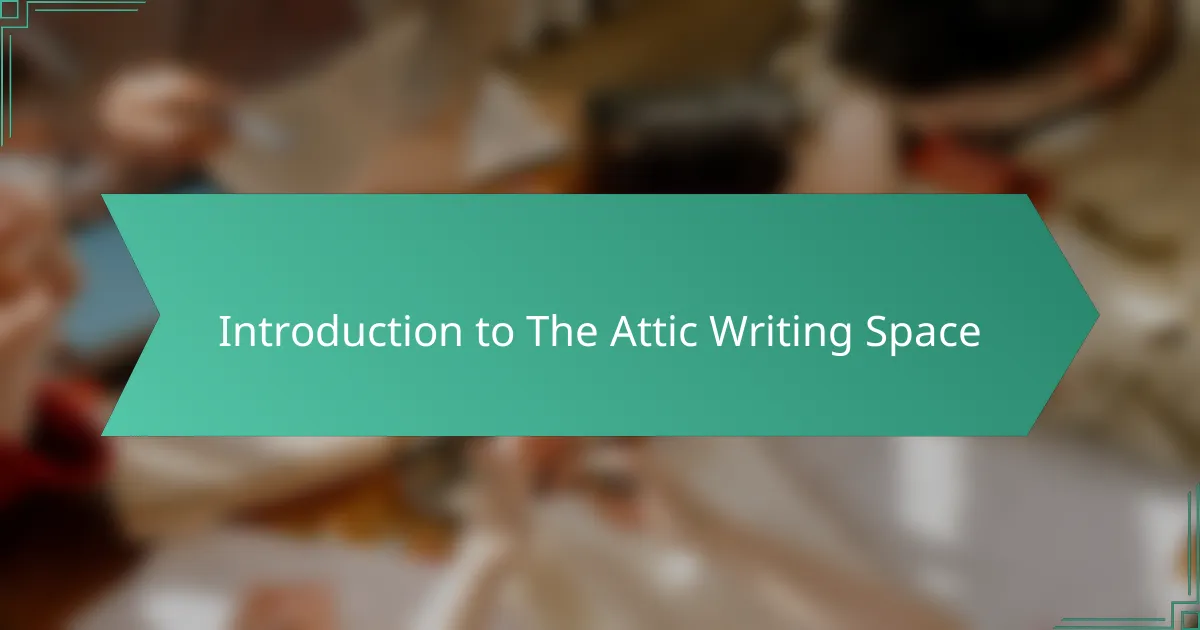Key takeaways
- Portland Writers Community fosters a supportive environment that enhances creativity and connections among writers.
- Participating in writers groups offers valuable feedback and accountability, transforming writing from a solitary task to a communal experience.
- The Attic Writing Space is designed to minimize distractions, nurturing focus and creativity through its calming atmosphere.
- Effective storytelling techniques include showing rather than telling, using conflict to build tension, and reading aloud to enhance narrative flow.

Portland Writers Community Overview
The Portland Writers Community feels like a hidden gem to me—a place where creativity flows freely and everyone’s story matters. Have you ever walked into a room and instantly sensed the buzz of shared passion? That’s exactly the vibe here.
From my experience, it’s not just about writing; it’s about the connections you build. The support and encouragement from fellow writers can turn a simple idea into a compelling tale. I’ve found that this sense of camaraderie makes Portland’s literary scene come alive in a unique way.
Isn’t it incredible how a community can inspire and push you to explore new depths in your craft? In Portland, that inspiration feels tangible, wrapped up in workshops, readings, and casual meet-ups that constantly spark new stories.

Benefits of Joining Writers Groups
Joining a writers group has always been a game-changer for me. When I share my work and receive honest, thoughtful feedback, it’s like discovering new angles I never saw before. Have you noticed how even a small suggestion can shift your entire perspective, making your story stronger and richer?
There’s also something deeply motivating about being surrounded by people as passionate about writing as you are. In those gatherings, the collective energy pushes me to write more consistently. I’ve experienced firsthand how the accountability of a group can turn writing from a solitary chore into a shared adventure.
Moreover, writers groups often open doors to diverse voices and styles. I love hearing different approaches and storytelling methods—it broadens my own toolbox and sparks unexpected inspiration. Isn’t that variety exactly what keeps our craft fresh and exciting?

Introduction to The Attic Writing Space
Stepping into The Attic Writing Space feels like entering a sanctuary designed just for words. Have you ever longed for a spot where distractions fade, and your story takes center stage? That’s the essence of this cozy, light-filled room perched above the city’s hum.
What struck me immediately was the intentional simplicity of the space—no flashy gadgets, just comfortable chairs, big windows, and quiet nooks inviting you to settle in. In those moments, I realize how crucial the environment is in shaping my focus and creativity.
Isn’t it fascinating how a physical space can nurture your inner storyteller? At The Attic, I’ve found that the calm and warmth it offers gently coax ideas out of hiding, making the craft of writing feel less like a task and more like a conversation with myself.

Crafting Stories at The Attic Techniques
One technique I appreciate at The Attic is starting with raw, unfiltered freewrites. Have you ever noticed how letting your thoughts spill onto the page without judgment can uncover unexpected gems? For me, these spontaneous beginnings often become the heartbeat of a story, capturing emotions that polished drafts sometimes miss.
Another approach that stands out is the collaborative revision sessions. Sitting around a table and hearing fresh perspectives sometimes feels like watching a sculpture take shape from a rough block. I’ve learned that being open to critique here doesn’t diminish my voice—it enriches it, helping me refine scenes that once felt stuck or bland.
Lastly, I find that The Attic’s gentle pacing encourages patience with the creative process. Isn’t it tempting to rush to finish? But in this space, I’ve come to value slowing down, letting characters breathe, and savoring the subtleties of each sentence. This mindfulness transforms storytelling from a race into an artful journey.

Personal Experiences at The Attic
There was one afternoon at The Attic that really stayed with me. I sat by the big window, notebook in hand, watching the raindrops fall against the glass as a new character quietly took shape on the page. Have you ever had a moment when the outside world seems to slow down just enough for your story to find its own rhythm? That’s exactly how it felt—like the space itself was encouraging the story to unfold naturally.
Sometimes, I’ve found The Attic to be a place of unexpected breakthroughs. During one group session, a fellow writer’s observation about my protagonist’s motivation struck a chord I hadn’t even noticed before. That honest feedback, given in such a warm and supportive setting, didn’t just improve the scene; it reshaped my whole approach to the narrative. Isn’t it amazing how a simple insight can open doors you didn’t even know were locked?
There’s also a quiet comfort in The Attic that makes it so personal for me. It’s not just the inviting chairs or the soft lighting—it’s the feeling that this is a creative home away from home. On more than one occasion, I’ve returned after a tough day to find solace in writing here, letting the space gently wash away the noise in my mind. Have you experienced a place where your ideas feel safe enough to bloom, no matter what else is happening? For me, The Attic has become exactly that.

Practical Tips for Storytelling
When I think about practical storytelling tips that truly work, one thing stands out: show, don’t just tell. Instead of saying your character is angry, I’ve found it far more powerful to describe the trembling hands or the quickening breath—details that invite readers to feel what the character feels. Have you noticed how those small sensory details instantly pull you in? That’s the magic of immersive storytelling.
Another tip I swear by is using conflict to drive your narrative forward. When I’m stuck, I ask myself, “What’s at stake here?” The higher the stakes, the stronger the tension, which keeps both me and my readers hooked. Sometimes, even introducing a simple obstacle can turn an ordinary moment into something compelling and unforgettable.
I also recommend reading your story out loud, preferably in a space like The Attic where the quiet helps you really hear the words. Hearing your story spoken lets you catch awkward phrasing or rhythm issues that the eyes might skim right over. From my experience, this practice breathes life into the writing and helps me connect more deeply with the voice I want to create.

How The Attic Enhances Creativity
What I love most about The Attic is how it strips away the usual distractions, creating a space solely dedicated to imagination. Have you ever noticed how simply changing your environment can spark ideas you didn’t even know were waiting to be discovered? For me, The Attic’s quiet charm feels like a creative reset button.
The natural light streaming through the windows seems to invite inspiration in ways artificial lighting never could. I’ve found that writing in such a warm, open atmosphere gently pushes my thoughts beyond the surface, helping me explore details I might have overlooked in a darker, more cluttered setting. Isn’t it fascinating how something as simple as sunlight can influence our creative flow?
Then there’s the subtle energy of others quietly working alongside me. Even without direct interaction, just knowing that fellow storytellers share this space fuels my motivation. It’s like the room hums with a shared purpose, encouraging me to dig deeper and take risks with my writing. Have you experienced that kind of creative electricity before? It’s truly something special.